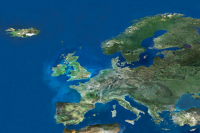Gateway to Think Tanks
| 来源类型 | Publications - Editorials |
| 规范类型 | 评论 |
| DOI | 978-2-86592-962-7 |
| Key Trends in the European Earth Observation Sector Actuelles de l'Ifri, The Europe & Space Series, No. 8, December 2011 | |
| Christophe VENET | |
| 发表日期 | 2011-12-18 |
| 出版年 | 2011 |
| 概述 | An ambitious Earth Observation (EO) policy could bring significant benefits to Europe both regarding the fight against climate change and the competitiveness of its EO industry and service sectors. |
| 摘要 |
Key Trends in the European Earth Observation Sector Actuelles de l'Ifri, The Europe & Space Series, No. 8, December 2011
An ambitious Earth Observation (EO) policy could bring significant benefits to Europe both regarding the fight against climate change and the competitiveness of its EO industry and service sectors.  Earth observation (EO) might well be the most complex of the three major space applications. It is used for civilian and military activities, it involves public and private actors, and it is at the crossroads of scientific and commercial endeavours. As a matter of fact, the EO sector is currently experiencing a boom. It is expected that 250 EO satellites will be launched between 2009 and 2018, compared to 128 during the previous decade. This is explained by the variety of applications derived from EO and by the attractiveness of EO satellites for new entrants, especially among emerging spacefaring nations. There are four major categories of EO data users: defence, science and R&D institutes, civil governments and private users. This paper will focus mostly on the three latter, although defence users will be included in the analysis on the growing commercialisation of the EO sector. However, dedicated military surveillance satellites will be left out from the analysis, as the problems and challenges attached to it are quite different from those of commercial or scientific projects. Military EO constellations in Europe are linked to sensitive issues such as cooperation in the defence area, sovereignty transfers and the emergence of a European identity in defence and security policy. However, defence considerations will not be completely ignored in the analysis, as the growing trend towards dual-use should be accounted for. The two most significant global trends in EO in the recent years have been an increasing focus on climate change issues, and the growing commercialisation of the EO sector. Several space agencies, most prominently ESA, NASA and JAXA, recently launched dedicated missions to study the effects of climate change. At the same time, the global EO data market has grown by a CAGR (Compound Annual Growth Rate) of 25% in the last five years, reaching $1.3 billion in 2010, and is expected to represent $4 billion by 2020. Developments in Europe are in line with these two global trends, although with certain specificities. As a whole, Europe’s policy in the field of EO supports two broader EU policy priorities identified at the 5th Space Council: space for climate change and space as a contribution to the Europe 2020 strategy. This reflects the fact that EO is at the intersection of science and the market. However, the current uncertainties over the future of GMES (Global Monitoring for Environment and Security), which is to become the cornerstone of Europe’s EO architecture, could compromise both the scientific and commercial benefits reaped from EO applications. This paper will first shed light on the contribution of EO missions to the climate change debate in the European context (1). It will then focus on recent developments in European data policy, as these have consequences both for the scientific community and for the commercial market (2). Finally, the characteristics and challenges of the commercial EO sector in Europe will be analysed, insisting on the central role played by public actors (3).
Key Trends in the European Earth Observation Sector
|
| 关键词 | climate change Space European Union |
| URL | https://www.ifri.org/en/publications/enotes/key-trends-european-earth-observation-sector |
| 来源智库 | French Institute of International Relations (France) |
| 引用统计 | |
| 资源类型 | 智库出版物 |
| 条目标识符 | http://119.78.100.153/handle/2XGU8XDN/415579 |
| 推荐引用方式 GB/T 7714 | Christophe VENET. Key Trends in the European Earth Observation Sector Actuelles de l'Ifri, The Europe & Space Series, No. 8, December 2011. 2011. |
| 条目包含的文件 | ||||||
| 文件名称/大小 | 资源类型 | 版本类型 | 开放类型 | 使用许可 | ||
| europeenvisat.jpg(25KB) | 智库出版物 | 限制开放 | CC BY-NC-SA |  浏览 | ||
| theeuropespaceseries(129KB) | 智库出版物 | 限制开放 | CC BY-NC-SA | 浏览 | ||
除非特别说明,本系统中所有内容都受版权保护,并保留所有权利。